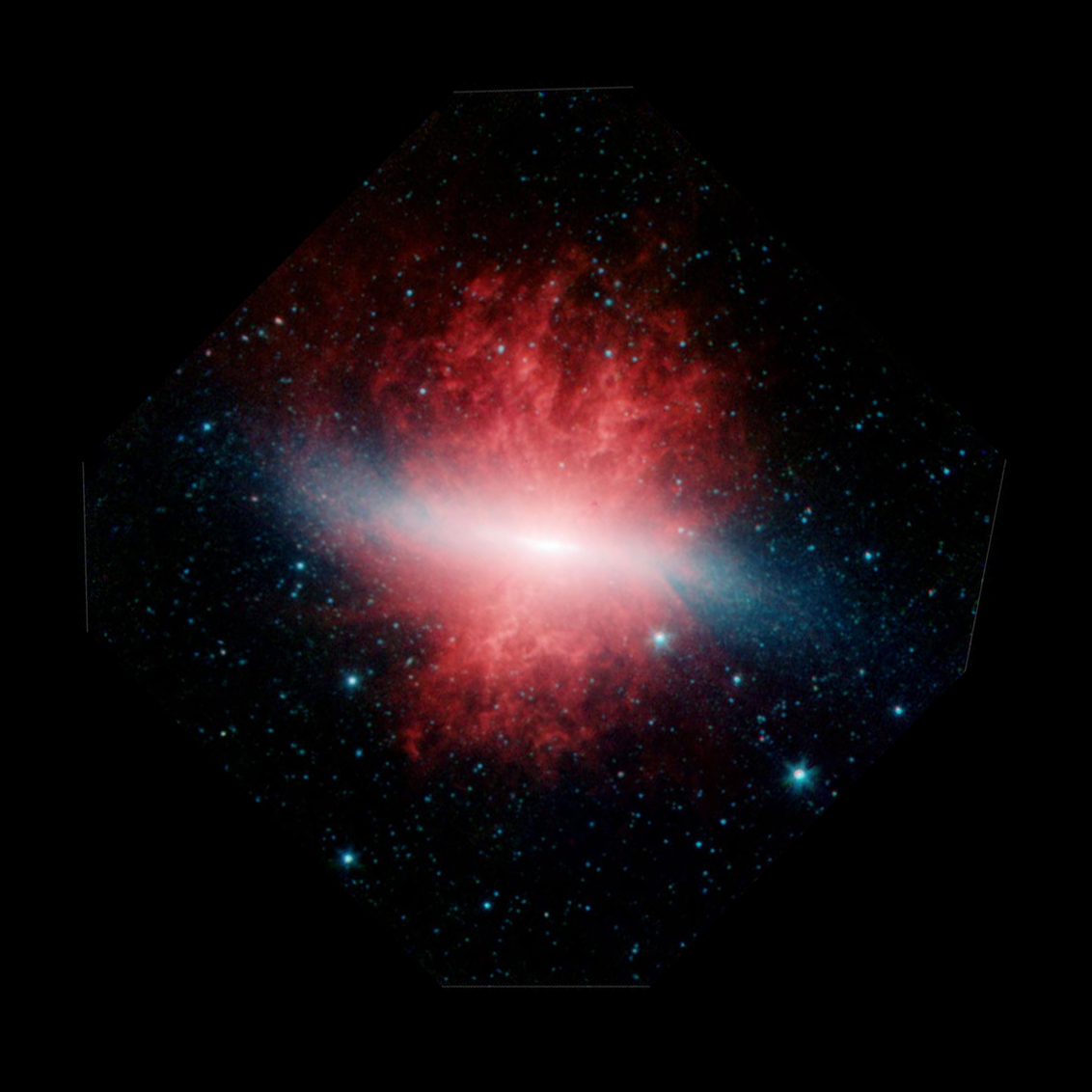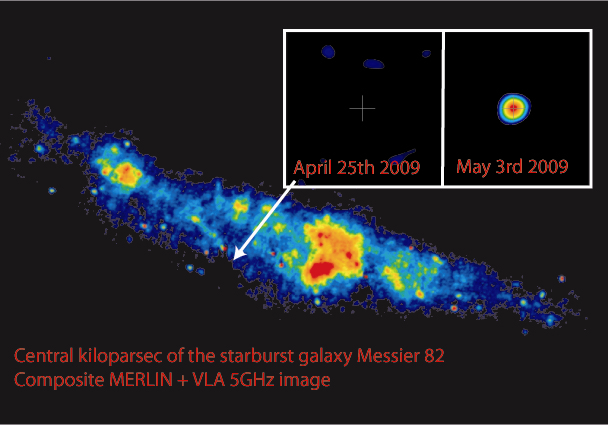
An image of galaxy M82 taken by the Spitzer Telescope. Supernova explosions in the core of the galaxy have produced a hot wind which can be seen escaping from galaxy in this infra-red image where dust emission is coloured red. Credit: NASA/JPL-Caltech.

Radio image of M82 made with the MERLIN and VLA telescopes. The resolution of the main image (the size of a pixel) is 100 milliarcseconds, the diameter of a 1 pence coin when viewed at a distance of 40 km. Insets show MERLIN images from April 25th and May 3rd 2009 demonstrating the sudden appearance of the mystery object. The resolution of these inset images is 40 mas. All images are at a frequency of 5 GHz. Credit: T.W.B. Muxlow, University of Manchester.
Mystery object in Starburst Galaxy M82 possible micro-quasar
14 April 2010
Radio astronomers at the University of Manchester’s Jodrell Bank Observatory have discovered a strange new object in a nearby galaxy. The object, which appeared very suddenly in radio wavelengths and shows no signs of going away, does not appear to be like anything that has been seen in the Milky Way. Dr Tom Muxlow will present the discovery at the National Astronomy Meeting in Glasgow on Wednesday 14th April.
The galaxy, known as M82, is 10 million light years away and is a stellar production line churning out new stars at a prodigious rate. However, many of these stars die quickly in huge explosions, with a new supernova explosion occurring every 20 to 30 years.
“The new object, which appeared in May 2009, has left us scratching our heads – we’ve never seen anything quite like this before,” said Dr Muxlow. “The object turned on very rapidly within a few days and shows no sign of decaying in brightness over the first few months of its existence. The new young supernova explosions that we were expecting to see in M82 brighten at radio wavelengths over several weeks and then decay over several months, so that explanation seems unlikely.”
The plausibility of a supernova explanation was further undermined when very accurate positional monitoring by the UK network of radio telescopes, MERLIN, tentatively detected a change in position for the object over the first 50 days. This was equivalent to an apparent superluminal motion of over 4 times the speed of light. Such large apparent velocities are not seen in supernova remnants and are usually only found with relativistic jets ejected from accretion disks around massive black hole systems.
The nucleus of M82, like most major galaxies, is expected to contain a super-massive black hole. The new detection lies at a position close to, but several arcseconds from the dynamical centre of M82 – far enough away that it would seem unlikely that this object is associated with the central collapsed core of this galaxy.
The new source could be the first radio detection of an extragalactic ‘micro-quasar’. Examples of such systems within the Milky Way are found as X-ray binaries with relativistic jets ejected from an accretion disk around a collapsed star fuelled with material dragged from a close binary companion. However, this object would be brighter than any Galactic example yet detected, has lasted months longer than any known X-ray binary, and lies at a position in M82 where no variable X-ray source has yet been detected.
If this object is an extragalactic micro-quasar, it would be the first that has been detected at radio wavelengths. The very high luminosity suggests that it is likely to be associated with a massive black hole system of some type; however this and its longevity imply that this type of object is extremely unusual and has not yet been seen within our Galaxy.
“We have just started processing data from an array of 20 radio telescopes across the Earth were taken for the central nuclear region of M82. These images will allow us to examine the structure of the new radio source in detail. However, processing such huge datasets takes significant amounts of computing effort and painstaking work. Only then will we be able to see if it is some rare form of micro-quasar. Watch this space…!” said Muxlow.
Contacts
Tom Muxlow
Jodrell Bank Centre for Astrophysics
University of Manchester
Alan Turing Building
Oxford Road
Manchester M13 9PL
Further Information
A paper on the discovery has been submitted to the Monthly Notices of the Royal Astronomical Society Letter is now accepted and on Astro-ph as arXiv:1003.0994.
M82
The nearby starburst galaxy M82 is a fascinating and spectacular example of a galaxy in which stars are being created. This burst of star-formation has been triggered by a near collision with its massive neighbouring spiral galaxy M81 and has been continuing for the past few millions of years. The central region of M82 is a very violent place with newly-formed high mass stars exploding in spectacular supernovae – a new explosion occurring every 20 to 30 years. For over 20 years astronomers at the University of Manchester observatory at Jodrell Bank have used the high-angular resolution imaging array MERLIN and the more widely-spaced European network of radio telescopes (EVN) to monitor the development and expansion of many recent supernova remnants in the nuclear region of M82. These were formed by supernova explosions within the last few hundreds of years. The ejected material is found to be expanding outward from the site of the explosion with velocities typically in excess of 10,000 km/s.
THE NEW OBJECT
As part of the monitoring programme, MERLIN observations detected a new faint point-like source of radio waves which appeared at the beginning of May 2009. The new object is 100 times fainter in the radio than the previous supernova explosions seen in M82 and, if it is a new supernova, it is clearly not of the same type. It is about the correct brightness to be a faint (type II) radio supernova, some nearby examples of which have been detected in the radio, however the very rapid turn on, its spectral characteristics, and lack of any significant decay in its flux density over the first 150 days of monitoring make this such a strange type II supernova, that this explanation is unlikely to be true.
RAS NATIONAL ASTRONOMY MEETING (NAM 2010)
The RAS National Astronomy Meeting 2010 will take place from 12-16th April at the University of Glasgow. The conference is held in conjunction with the UK Solar Physics (UKSP) and Magnetosphere Ionosphere and Solar-Terrestrial Physics (MIST) meetings. NAM2010 is principally sponsored by the Royal Astronomical Society (RAS) and the University of Glasgow.
THE ROYAL ASTRONOMICAL SOCIETY
The Royal Astronomical Society (RAS), founded in 1820, encourages and promotes the study of astronomy, solar-system science, geophysics and closely related branches of science. The RAS organises scientific meetings, publishes international research and review journals, recognises outstanding achievements by the award of medals and prizes, maintains an extensive library, supports education through grants and outreach activities and represents UK astronomy nationally and internationally. Its more than 3000 members (Fellows), a third based overseas, include scientific researchers in universities, observatories and laboratories as well as historians of astronomy and others.


